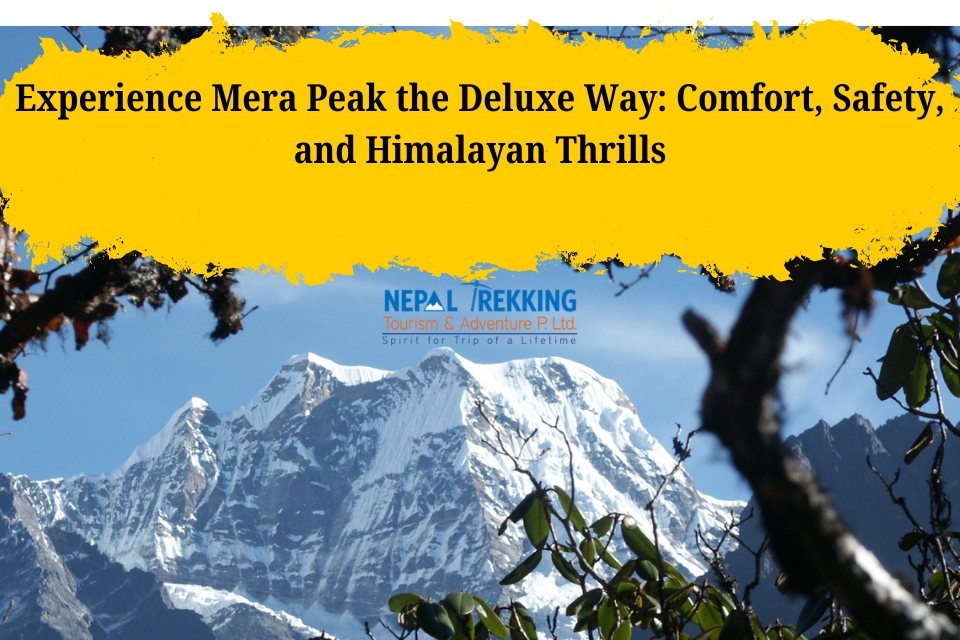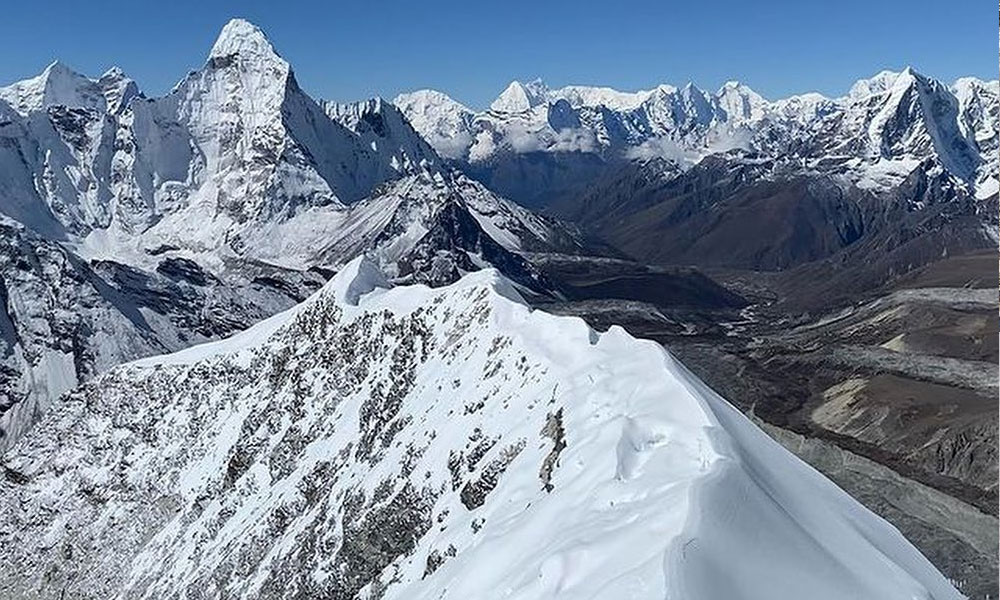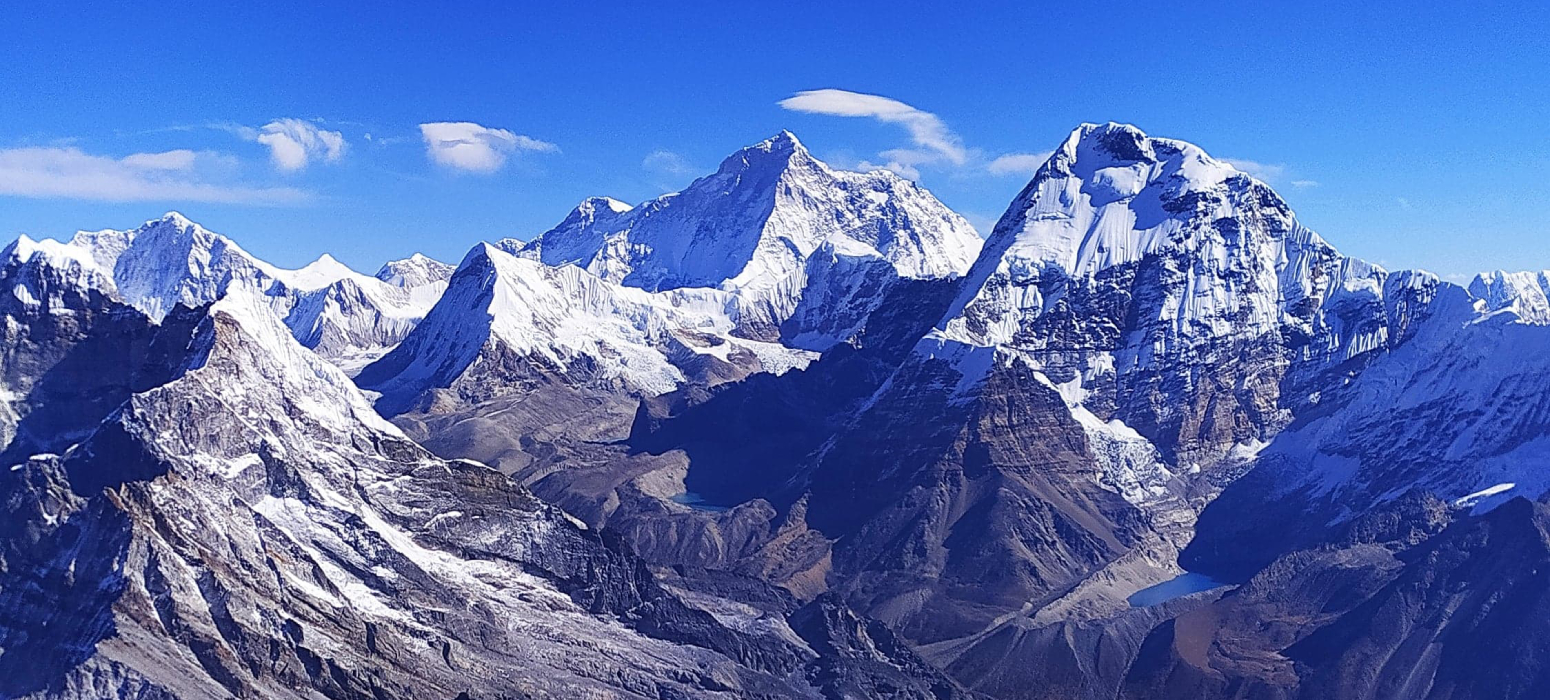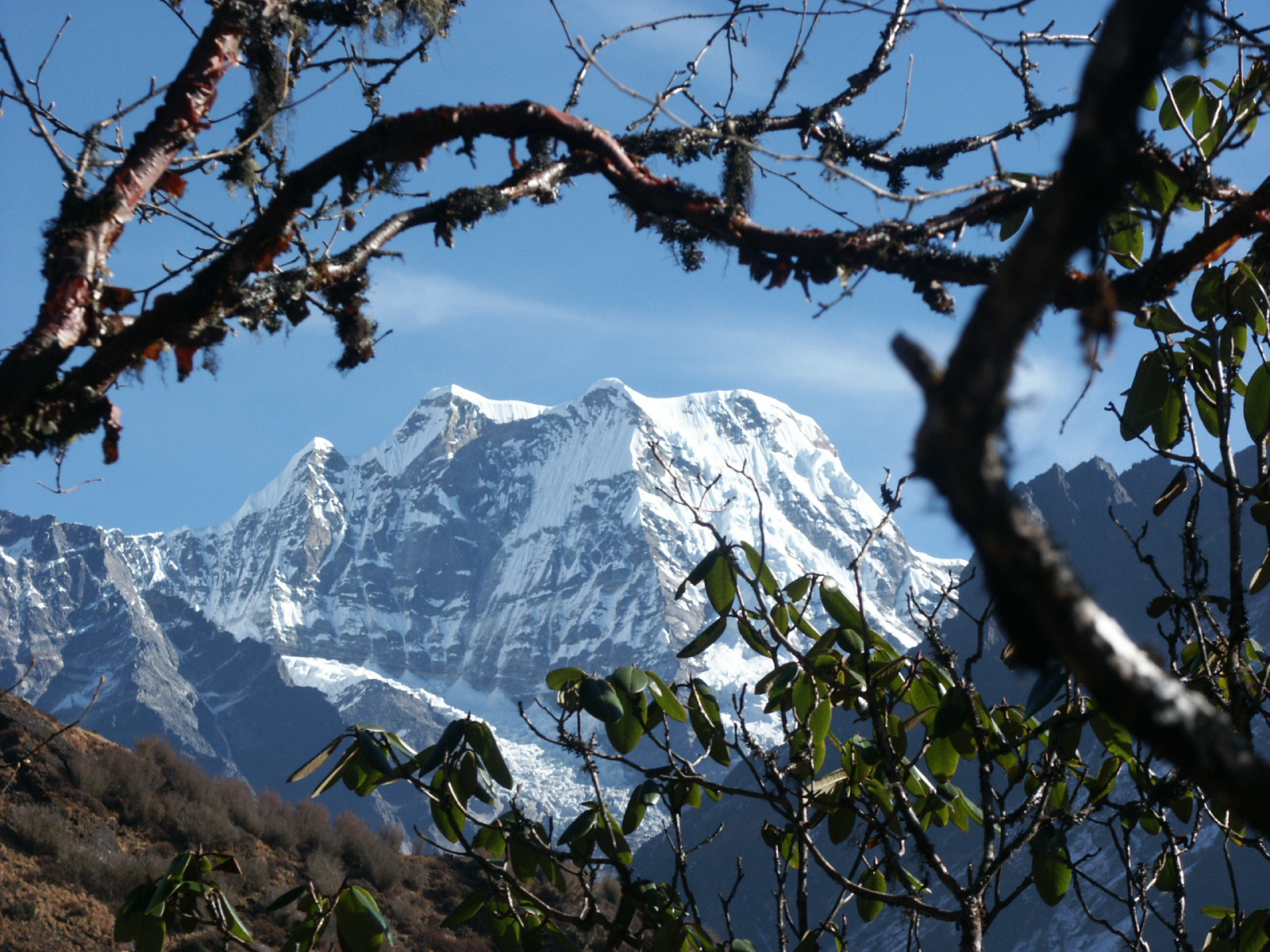Experience Mera Peak the Deluxe Way: Comfort, Safety, and Himalayan Thrills
Mera Peak, standing at 6,476 meters (21,247 feet), is the highest permitted trekking peak in Nepal, located in the remote and pristine Hinku Valley of the Everest region. Renowned for its accessible yet adventurous climbing route, Mera Peak offers one of the best introductory experiences to high-altitude mountaineering in the Himalayas. It presents an excellent opportunity for trekkers with moderate experience to achieve a Himalayan summit and witness an unparalleled panoramic view of the world’s tallest mountains.
The expedition typically begins with a short scenic flight from Kathmandu to Lukla, the famous mountain airstrip that serves as the gateway to the Everest region. From Lukla, the journey branches away from the popular Everest Base Camp trail and ventures into the less-traveled Hinku Valley. This trail is remote, wild, and filled with diverse natural beauty, ranging from lush rhododendron forests and glacial rivers to alpine meadows and high-altitude landscapes. The route to Mera Peak passes through charming villages like Chutanga, Kothe, and Khare, with ample time allotted for acclimatization to ensure safety and comfort at high elevations.
As climbers ascend toward Mera Base Camp and High Camp, the terrain becomes more rugged and icy. The climb to the summit is generally considered non-technical, making it suitable for fit trekkers with basic mountaineering skills. However, the use of crampons, ropes, and ice axes is required as the final push involves traversing glaciers and ascending a snowy ridge. The ascent is physically demanding due to altitude and cold conditions, but it does not require advanced technical climbing experience.
The true highlight of the Mera Peak Expedition is the summit itself. From the top, climbers are rewarded with what is often described as the best view in the entire Himalayas. On a clear day, you can see five of the world’s tallest mountains—Everest (8,848m), Lhotse (8,516m), Makalu (8,485m), Cho Oyu (8,188m), and Kangchenjunga (8,586m)—forming a magnificent panorama that few other peaks can offer.
In terms of preparation, trekkers are advised to be in good physical condition. Previous trekking experience at altitude is helpful, and participating in basic mountaineering training before the trip is highly recommended. The expedition is fully supported by experienced guides, porters, and sometimes high-altitude sherpas who ensure the safety, logistics, and overall success of the climb.
Accommodation throughout the trek is a mix of teahouses and tented camps. Lower elevations typically offer rustic but comfortable teahouses where trekkers can enjoy hot meals and a cozy place to rest. At higher altitudes, especially beyond Khare, tented camps are used for flexibility and safety, particularly at Mera Base Camp and High Camp.
The best seasons for the Mera Peak expedition are spring (March to May) and autumn (September to November). These months offer the most stable weather, excellent visibility, and ideal conditions for trekking and climbing. Monsoon and winter climbs are less common due to heavy rainfall, snowfall, and harsh cold.
Several route variations are available, but the most common and scenic approach is via the Hinku Valley, which provides a longer but more gradual and acclimatization-friendly trek. An alternate, more challenging route involves crossing the Zatra La Pass early in the trek, offering a shorter itinerary but a steeper and more physically demanding approach.
Overall, the Mera Peak expedition is ideal for trekkers seeking a true Himalayan climbing experience with relatively low technical difficulty. It offers a combination of remote wilderness, cultural exposure, adventure, and high-altitude achievement. The journey not only pushes personal limits but also rewards with one of the most dramatic and majestic Himalayan vistas imaginable. For those aspiring to experience their first Himalayan summit, Mera Peak stands as a compelling and unforgettable choice.
What are the Major Highlights of the Deluxe Mera Peak Expedition?
1. Scenic Mountain Flight to Lukla
The adventure begins with an unforgettable flight from Kathmandu to Lukla, one of the most thrilling airports in the world. The 30-minute flight offers breathtaking aerial views of the Himalayas and the lush green hills of Nepal’s countryside. With deluxe service, travelers can expect priority seating and smoother check-in/transfer assistance.
2. Remote and Untouched Hinku Valley
Unlike the busy Everest Base Camp trail, Mera Peak lies in the secluded Hinku Valley, a rarely visited part of the Khumbu region. This pristine valley is rich in biodiversity, dotted with alpine forests, glacial rivers, and culturally authentic Sherpa villages. The deluxe package ensures well-organized logistics and premium accommodations even in this remote setting.
3. Well-Planned Acclimatization Itinerary
One of the key highlights of a deluxe expedition is the carefully crafted itinerary that includes multiple acclimatization days. This not only enhances your safety but increases summit success. During these rest days, you’ll enjoy scenic hikes to higher altitudes and relax with superior comforts in teahouses or tents equipped with extra amenities.
4. Experienced and Certified Climbing Guides
A major advantage of the deluxe package is the inclusion of highly experienced, government-licensed trekking and climbing guides. These professionals offer one-on-one support, in-depth safety briefings, and personalized training on using climbing gear such as ice axes, ropes, and crampons.
5. Panoramic Views from the Summit
Reaching the summit of Mera Peak (6,476 meters) is the ultimate reward. From the top, climbers are treated to a stunning 360-degree Himalayan panorama, including five 8,000-meter peaks: Everest, Lhotse, Makalu, Cho Oyu, and Kanchenjunga. These are among the most iconic views anywhere in the Himalayas and are especially striking during sunrise.
6. Deluxe Accommodation and Dining
Throughout the expedition, deluxe trekkers enjoy upgraded accommodations in the best available teahouses, as well as high-quality camping facilities in remote areas. Meals are hygienic, nourishing, and often customized to dietary preferences. Some deluxe packages include a private chef or kitchen crew at higher camps for fresh meals in extreme conditions.
7. High Camp Experience
The overnight stay at Mera High Camp (approx. 5,800 meters) is a thrilling part of the expedition. Tents are equipped with insulated sleeping pads, down sleeping bags, and heated food services. The views from High Camp are surreal, with sunset and sunrise over the Himalayan giants providing once-in-a-lifetime photo opportunities.
8. All-Inclusive Support Crew
A deluxe expedition includes a full support team of guides, porters, kitchen staff, and sometimes even a climbing Sherpa for summit assistance. Your luggage is carried for you, and camp setups are taken care of in advance—allowing you to fully enjoy the journey without logistical stress.
9. Cultural Encounters with the Sherpa Community
Along the trail, you’ll pass through traditional Sherpa settlements where you can interact with locals, visit Buddhist monasteries, and learn about mountain life. A deluxe expedition may include arranged cultural experiences like Sherpa cooking lessons, monastery blessings, or village tours.
10. Comprehensive Safety Measures
Deluxe Mera Peak expeditions prioritize safety with emergency oxygen, satellite phones, medical kits, and well-prepared rescue plans in place. Daily health checks are often conducted by the team leader, and itineraries are flexible in case of altitude-related issues.
11. Pre- and Post-Trek Luxury in Kathmandu
Your deluxe experience extends beyond the trek itself. Most packages include accommodations in high-end hotels in Kathmandu (like Hyatt, Marriott, or Dwarika’s) before and after the expedition, plus guided sightseeing tours of UNESCO World Heritage Sites in the Kathmandu Valley.
The Deluxe Mera Peak Expedition offers an ideal combination of adventure, comfort, safety, and culture. It is perfect for trekkers seeking a personalized, well-supported, and memorable journey to one of Nepal’s most iconic trekking peaks. With premium logistics and expert guidance, you can focus on the adventure while everything else is taken care of.
Why Make It a Deluxe Mera Peak Expedition with Nepal Trekking Tours (P) Ltd?
Choosing the Deluxe Mera Peak Expedition with Nepal Trekking Tours (P) Ltd means elevating your Himalayan adventure to a premium, comfortable, and worry-free experience—without compromising the thrill and authenticity of the climb. Here are the key reasons why this company stands out as your trusted partner for a deluxe expedition:
1. Expertly Designed Itinerary with a Focus on Safety and Success
Nepal Trekking Tours offers a thoughtfully designed itinerary that includes gradual altitude gain, rest/acclimatization days, and flexibility for weather or health conditions. Their careful planning increases your chances of summit success while minimizing the risk of altitude sickness—essential for a safe and enjoyable expedition.
2. Top-Class, Certified Climbing Guides and Support Team
Your safety and success depend on the people you trek with. Nepal Trekking Tours (P) Ltd employs government-licensed certified climbing guides and experienced local Sherpas who are intimately familiar with the Mera Peak region. Their deep expertise, friendly guidance, and focus on customer care make the experience smoother and more enriching.
3. Premium Logistics and Gear Management
Deluxe means convenience and comfort—even in high mountains. Nepal Trekking Tours provides:
- High-quality camping equipment (insulated tents, sleeping bags, mats)
- Proper climbing gear (ropes, crampons, harnesses, etc.)
- Satellite communication for emergencies
- Oxygen support and medical kits
- These inclusions are often missing from standard budget treks.
4. Superior Accommodation and Meals
While most treks offer basic teahouses and shared rooms, the deluxe package includes:
- Best-available lodges and rooms en route
- Upgraded tented camps at base and high camp
- Professional cook and kitchen team providing fresh, hygienic, and nourishing meals even at high altitudes
- Your comfort, health, and dietary needs are prioritized every step of the way.
5. Small Group Sizes and Personalized Service
Nepal Trekking Tours focuses on small group experiences or fully private departures, allowing for personalized attention, better guide-to-guest ratios, and a more relaxed pace. You’re not just another number; your comfort and journey matter.
6. Responsible and Ethical Trekking Practices
This company is committed to eco-friendly and culturally respectful tourism. Their porters and staff are well paid, insured, and equipped. Waste is managed responsibly, and local communities are supported through sustainable travel practices. Choosing them means you’re supporting ethical tourism in the Himalayas.
7. Seamless Pre- and Post-Trek Experience
The deluxe experience extends to:
- Airport pickups and private transfers
- 4–5 star hotel stays in Kathmandu (e.g., Dwarika’s, Marriott)
- Heritage sightseeing tours with licensed guides
- Assistance with domestic flights, permits, and documentation
- All logistics are taken care of so you can relax and focus on the adventure.
8. Excellent Client Reviews and Reputation
Nepal Trekking Tours (P) Ltd has a solid track record of happy clients, many of whom return for future trips. Their reputation is built on trust, reliability, and exceeding expectations in both trekking and expedition services.
9. Flexible Customization Options
Every adventurer is unique. Whether you want a private expedition, extended itinerary, helicopter return, or luxury upgrades in Kathmandu, Nepal Trekking Tours is happy to customize your Mera Peak experience according to your preferences and timeline.
10. Transparent Pricing and Value
With no hidden fees, clear inclusions, and premium services bundled in, the deluxe package from Nepal Trekking Tours offers excellent value. What you pay for is what you receive—comfort, safety, support, and unforgettable memories.
Why choose Nepal Trekking Tours (P) Ltd for your Deluxe Mera Peak Expedition?
Because they combine professionalism, safety, comfort, and personal care with a deep love for the Himalayas. From the moment you land in Nepal to the triumphant summit and safe return, you're in expert hands—every detail managed, every step supported.
Things to Remember During Deluxe Mera Peak Expedition
Embarking on a Deluxe Mera Peak Expedition is an incredible adventure, but success and enjoyment depend on proper preparation, awareness, and attitude. Here’s a detailed list of important things to remember before and during your journey:
1. Acclimatization is Key
- Mera Peak stands at 6,476 meters, and altitude sickness is a real risk.
- Follow the itinerary closely, take scheduled rest/acclimatization days seriously, and never rush the ascent.
- Stay hydrated, avoid alcohol, and communicate any symptoms (headache, nausea, fatigue) to your guide immediately.
2. Physical & Mental Fitness
- This is a demanding expedition that requires good physical endurance and mental resilience.
- Engage in pre-trip training: cardio (hiking, running, cycling), strength, and altitude preparation if possible.
- Be prepared to walk 6–8 hours per day over rugged terrain and snowy conditions.
3. Learn to Use Basic Mountaineering Gear
- You’ll be using crampons, ice axe, harness, and ropes on summit day.
- Even in a deluxe trip with support, it’s important to know how to wear and handle this equipment.
- Basic instruction is usually provided before the climb—pay close attention and ask questions if unsure.
4. Pack Smart but Light
Even though porters carry most of your gear, your daypack should have:
- Water, snacks, camera, gloves, headlamp
- Extra layers (windproof, warm fleece/down)
- Personal medical kit, sunscreen, lip balm
- Deluxe trips often provide high-quality tents, sleeping bags, and climbing gear—but confirm this in advance with the company.
5. Weather Can Change Quickly
- Be mentally and physically prepared for unpredictable conditions—especially at high altitudes.
- Expect sudden snowfall, wind, and cold during the climb, particularly at night and early mornings.
- Follow your guide's advice closely during harsh weather.
6. Listen to Your Guide
- Your guide is your lifeline in the mountains—trust their decisions, especially regarding timing, acclimatization, or descent.
- They monitor health and weather conditions constantly and will adjust the plan if needed for safety.
7. Respect the Environment and Local Culture
- Practice Leave No Trace principles—don’t litter, avoid plastic, and respect wildlife.
- Show cultural respect to Sherpa communities—ask before taking photos, dress modestly, and greet with a smile or a “Namaste”.
8. Stay Hydrated and Eat Well
- Drink 3–4 liters of water daily. Use purification tablets or boiling.
- Deluxe expeditions offer hygienic, nutrient-rich meals—eat well even if you’re not hungry, as calories are essential at high altitudes.
- Avoid alcohol, especially at high elevations.
9. Prepare for Summit Day
- Summit day is long and starts around 2–3 AM—it’s cold, dark, and physically demanding.
- Pack your summit bag the night before: headlamp, snacks, water, camera, spare gloves, and down jacket.
- Stay positive and take it one step at a time—the reward is unforgettable.
10. Travel Insurance is a Must
-
Make sure your insurance covers high-altitude trekking and climbing (up to 6,500m), emergency evacuation by helicopter, and medical care.
-
Carry a copy of your policy and inform your trekking company of your insurance details.
11. Be Flexible and Stay Positive
- In the mountains, plans can change due to weather, health, or logistics.
- A deluxe trip offers comfort, but nature remains unpredictable—stay open-minded and adaptable.
- Your positive attitude will be as important as your gear!
12. Tipping and Gratitude
- Porters, guides, and cooks work hard behind the scenes. Tipping is customary and a gesture of appreciation.
- Prepare envelopes or carry extra cash (in NPR or USD) for tips at the end of the trip.
A Deluxe Mera Peak Expedition blends high-altitude adventure with well-managed logistics and comfort—but your awareness, preparation, and respect are what turn it into a truly life-changing journey.
How Difficult is Mera Peak Expedition Compared to Other Peak Expeditions in Nepal?
Mera Peak (6,476 meters) is often considered a moderately challenging expedition, especially when compared to other popular climbing peaks in Nepal. While it's the highest trekking peak allowed by the Nepal Mountaineering Association (NMA), it's technically less demanding than many others. Here's a detailed comparison to help understand its difficulty level relative to other expeditions:
Mera Peak – Difficulty Overview
- Altitude: 6,476 m (21,247 ft) – high altitude makes acclimatization critical.
- Technical Challenge: Low – mostly glacier walk; final ascent includes a short steep section that may require fixed ropes.
- Climbing Gear Use: Crampons, ice axe, rope, harness.
- Fitness Required: Good physical condition with high stamina for long trekking days and summit push.
- Experience Level: Suitable for strong trekkers with basic mountaineering skills or training.
How Mera Peak Compares to Other Peak Climbing in Nepal?
1. Island Peak (Imja Tse) – 6,189 m
-
Difficulty: Higher technical difficulty than Mera.
- Challenges: Steep ice walls (45–60°), narrow summit ridge, ladder crossings over crevasses.
- Required Skills: Rope handling, ice climbing techniques.
- Verdict: Island Peak is technically more difficult despite being lower in altitude.
-
Difficulty: High – steeper climbing with more exposure.
- Technicality: Requires fixed rope ascents, use of jumar and descent via rappel.
- Verdict: More technical and demanding than Mera Peak.
3. Pisang Peak – 6,091 m
-
Difficulty: Moderate to technical.
- Terrain: Includes rocky and icy sections; requires basic climbing skills.
- Verdict: Slightly more technical than Mera, but lower in altitude.
4. Tent Peak (Tharpu Chuli) – 5,663 m
-
Difficulty: Moderate.
- Climb Type: Mixed terrain – snow, rock, and ice.
- Verdict: Lower altitude and technical difficulty; easier than Mera.
5. Chulu Far East – 6,059 m
-
Difficulty: Moderate to technical.
- Approach: Long trek and summit involves fixed rope and snow climbing.
- Verdict: Comparable or slightly more technical than Mera Peak.
Why Mera Feels Challenging Despite Being “Non-Technical”?
- Extreme Altitude: At 6,476m, oxygen levels are very low, making simple walking feel exhausting.
- Cold and Wind: Harsh weather, especially near high camp and summit.
- Summit Push: Starts in early morning darkness, with a long ascent over snowfields and final steep ridge.
- Glacier Travel: Risk of crevasses, although route is well-managed in guided expeditions.
Mera Peak is one of the most achievable 6,000+ meter peaks in Nepal for fit trekkers looking to enter the world of Himalayan climbing. Its low technicality but high altitude make it a physically demanding but manageable climb, especially with proper acclimatization and guidance.
Compared to Island Peak or Lobuche East, Mera is easier technically but tougher in altitude. It’s a perfect first Himalayan summit for those aiming higher in the future.
Deluxe Mera Peak Expedition – FAQs
1. How difficult is Mera Peak to climb?
Mera Peak is considered a non-technical climbing peak, but it is physically demanding due to its high altitude (6,476m). It involves glacier walking and a steep final ascent that may require fixed ropes. With proper acclimatization and guidance, it’s achievable for fit trekkers with basic mountaineering training.
2. Do I need previous climbing experience?
Not necessarily. Mera Peak is suitable for beginners with strong trekking experience and good physical fitness. Prior experience with basic mountaineering gear like crampons, ice axe, and rope work is helpful but not mandatory in deluxe guided expeditions.
3. What makes it a "deluxe" expedition?
A Deluxe Mera Peak Expedition includes:
- Expert climbing guides and Sherpa support
- Best-available lodges and quality tented camps
- Hygienic, customized meals
- Extra acclimatization days
- High-quality equipment (tents, sleeping bags, etc.)
- Kathmandu luxury hotels, private transfers, and guided tours
4. What is the best time to climb Mera Peak?
The best seasons are:
- Spring (March to May) – stable weather, warmer temperatures
- Autumn (September to November) – clear skies and dry conditions
- Climbing in winter or monsoon is not recommended due to extreme cold or heavy rainfall.
5. How long is the expedition?
A typical deluxe Mera Peak expedition lasts 18 to 21 days, depending on the route and acclimatization plan. Some itineraries may include extra days for weather delays or helicopter returns.
6. What gear do I need for the climb?
You’ll need proper gear including:
- Mountaineering boots
- Crampons, harness, helmet, ice axe
- Warm layered clothing (down jacket, thermal base layers)
- Sleeping bag (-20°C to -30°C rated)
- Most deluxe expeditions provide or rent technical gear and high-quality sleeping equipment. A detailed packing list is usually provided after booking.
7. What type of accommodation can I expect?
-
Kathmandu: 4–5 star luxury hotels (e.g., Marriott, Dwarika’s)
- Trekking: Best teahouses available on the route
- Base & High Camps: High-altitude tents with foam mattresses and warm sleeping bags
- Deluxe expeditions prioritize comfort, cleanliness, and service.
8. Is altitude sickness a concern?
Yes. The high elevation increases the risk of Acute Mountain Sickness (AMS). Deluxe trips include proper acclimatization days, trained guides to monitor health, and oxygen or evacuation plans if needed.
9. Will there be internet and electricity?
-
Internet: Available at lower teahouses (with fees), but very limited or unavailable at higher altitudes.
- Electricity: Available in villages for charging devices (often for a small fee). At camps, solar or battery backup is used. Bring a power bank or solar charger.
10. Do I need travel insurance?
Yes. Comprehensive travel insurance is mandatory, and it must cover:
- High-altitude trekking and climbing (up to 6,500m)
- Helicopter evacuation
- Trip cancellations or delays
- Provide your insurance details before the trip.
11. How safe is the expedition?
Deluxe expeditions prioritize safety with:
- Certified climbing guides
- Medical kits and oxygen
- Satellite phone communication
- 24/7 support and evacuation readiness
- Your safety is the #1 priority.
12. How do I prepare physically?
Start training at least 8–12 weeks before the trip with:
- Cardio (hiking, running, swimming)
- Strength (core, legs, and back)
- Altitude training (if available)
- Consistency is key. Mental endurance is just as important.
13. What permits are required?
Nepal Trekking Tours (P) Ltd will arrange:
- Mera Peak Climbing Permit
- Makalu Barun National Park Entry
- Local Government (Khumbu) Permit
- You don’t have to handle permits yourself.
-
14. Can I customize the trip or add helicopter return?
Yes! Deluxe packages are fully customizable. You can:
- Add helicopter return from Khare or Lukla
- Extend the trip with side treks or cultural tours
- Choose private group departures or solo luxury climbs
15. How much does the deluxe expedition cost?
Prices vary by season, group size, and services but usually range from USD 3,000 to 4,500 per person. This includes guides, permits, accommodation, meals, and more. Helicopter return and gear rental may be extra.

Conclusion: Deluxe Mera Peak Expedition
The Deluxe Mera Peak Expedition is more than just a high-altitude adventure—it's a seamless blend of challenge, comfort, and cultural immersion. As the highest trekking peak in Nepal, Mera offers breathtaking Himalayan views, remote trails through the pristine Hinku Valley, and the thrill of standing atop a snow-covered summit above 6,400 meters.
What sets the deluxe experience apart is the attention to detail: expertly crafted itineraries, certified guides, premium accommodation, personalized service, and strong safety measures—all designed to maximize your success and enjoyment. Whether you're a seasoned trekker looking to summit your first Himalayan peak or a passionate traveler seeking a luxurious yet adventurous journey, this expedition delivers on every level.
With Nepal Trekking Tours (P) Ltd, you're not just climbing a mountain—you're embracing a fully supported, culturally rich, and unforgettable expedition that respects your time, effort, and aspirations.
Choose the deluxe route. Climb higher. Travel better. Live the Himalayan dream with confidence.
Recent Blog
- Deluxe Lobuche Peak Expedition Guide : Comfort Meets Challenge in the Everest Region
- Deluxe Island Peak Climbing Expedition Complete Guide
- Experience Mera Peak the Deluxe Way: Comfort, Safety, and Himalayan Thrills
- Deluxe Upper Mustang Trekking : Travel Guide
- Best of Top 7 (Seven) Luxury Trekking Packages in Nepal
- Nepal Luxury Tour Package | Why Make it Different?
- Complete Guide for Deluxe (Luxury) Trekking Package in Nepal
- Luxury Everest Trek | EBC Deluxe Trek
- Why Choose Deluxe Trekking in Nepal? The Benefits of Deluxe Lodges trek in Nepal
- Top 7 Luxury Treks in Nepal




